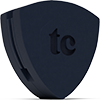Check out my custom vibration dampener
Tennis Elbow Symptoms
A Basic Overview
Let’s be real. If you’re here, there’s a good chance you’re not feeling too hot. We’re sorry to hear that.
And while there’s certainly nothing we can say or do to help make the pain go away, we can help you understand what exactly tennis elbow is as well as common symptoms. This way, you can hopefully gain a sense of whether or not you’re dealing with tennis elbow or not.
Article Contents
Click below to jump to a section
Tap below to jump to a section
Overview
Definition
Symptoms
New to TennisCompanion?
Create a free account and explore my latest videos below
Overview
Each year, roughly five out of a thousand people are diagnosed with tennis elbow. With over 300 million people in the US, that means more than a million people have the unfortunate luck of tennis elbow.
Shockingly, tennis elbow impacts half of all people who participate in racquet sports.
For some, the pain may be slight – an uncomfortable sensation on the outer side of your arm where your forearm muscle connects to the bone in your elbow.
For others, the pain may feel like someone’s pouring hot coal and molten lava over your arm while someone gives you thousands of tiny paper cuts and fire ants dance on your arm like an NYC rave.
Well, maybe not exactly that bad.
Unfortunately, it’s not cut and dry. But, let’s first take a look at how tennis elbow is commonly defined.
Definition of Tennis Elbow
Our definition would likely be a little more straightforward, like, dull pain on the outer part of the forearm that’s driving me nuts, pissing me off and making it hard to play my best tennis.
Since that’s less than official-sounding description, let’s take a look at how a few reputable resources define tennis elbow.
As defined by MayoClinic:
“Tennis elbow is a painful condition that occurs when tendons in your elbow are overworked, usually by repetitive motions of the wrist and arm. The pain of tennis elbow occurs primarily where the tendons of your forearm muscles attach to a bony bump on the outside of your elbow. Pain can also spread into your forearm and wrist.”
Another by the American Academy of Orthopaedic Surgeons, AAOS:
“Tennis elbow, or lateral epicondylitis, is a painful condition of the elbow caused by overuse. Not surprisingly, playing tennis or other racquet sports can cause this condition. But several other sports and activities can also put you at risk.
Tennis elbow is an inflammation of the tendons that join the forearm muscles on the outside of the elbow. The forearm muscles and tendons become damaged from overuse — repeating the same motions again and again. This leads to pain and tenderness on the outside of the elbow.”
One more by, MedicineNet:
“Tennis elbow is a condition that produces severe, burning pain over the bone at the side of the elbow. The pain results from inflammation of the tendon that attaches muscle to the bony projection (called the epicondyle) on the outside of the elbow.
Tennis elbow usually begins with mild pain and can worsen over time. The pain is exacerbated by pressing on the affected area or by lifting objects, particularly with extension of the wrist. Using a screwdriver can worsen the injury and cause pain. In advanced cases, even simple movements of the elbow joint can produce pain.”
Yuck, right?
There’s no doubt, tennis elbow sucks, but how can we be sure we’re dealing with tennis elbow? Truthfully, the best way to know for sure is to have a doctor diagnose you. However, let’s take a look at some of the common symptoms that would help you recognize your plight.
Tennis Elbow Symptoms
At first, you may not know what to think about the curious pain in your arm. Here are some symptoms provided by WebMD that should help:
- Tennis elbow symptoms usually begin gradually. The main symptom is pain, which may start with a dull aching or soreness on the outer part of the elbow that goes away within 24 hours after an activity.
- As time goes on, it may take longer for the pain to go away. The condition may further progress to pain with any movement, even during everyday activities, such as lifting a jug of milk. Pain may spread to the hand, other parts of the arm, shoulder, or neck.
- Usually occurs in the dominant arm (your right arm if you are right-handed, left arm if you are left-handed).
- It affects the outside of the elbow (the side away from your body). Pain increases when that area is pressed or when you are grasping or twisting objects.
- May increase in the evening and make sleep difficult. The elbow might be stiff in the morning.
- Overtime may occur with mild activity, such as picking up a coffee cup, turning a jar lid, doorknob, or key, or shaking hands. Simply starting your car could hurt. You may even have pain when you aren’t using your elbow.
- Other parts of the arm, shoulder, and neck may also become sore or painful as the body tries to make up for the loss of elbow movement and strength.
- Swelling rarely occurs with tennis elbow. If your elbow is swollen, you may have another type of condition, such as arthritis.
Did we mention tennis elbow sucks?
It’s true, but for some, it’s a reality. In our next article, we’ll take a look at common treatments for tennis elbow and what you can do to help protect yourself.
So, What’s Next?
If you’re concerned about tennis elbow or think you have it don’t hesitate to give your doctor a call. They’re well equipped to help diagnose the condition and suggest a proper treatment plan. For example, they might recommend a tennis elbow brace.
One thing is for sure; it’s not worth suffering through the pain. While for most people, the pain may come and go and be more of an annoyance, it can be a serious issue. Getting the help you need will ensure you stay healthy and can spend many more happy hours enjoying yourself out on the court.
Disclaimer: TennisCompanion or any of its staff are not licensed health care professionals or nutritionists. While we go to great lengths to research and provide our readers with accurate and helpful information, you should always consult your physician for proper diagnosis, or when making lifestyle changes including your diet or eating habits.
Photo Credit: FedererFan07
Play Better Tennis
Improve your game alongside our community of tennis players
Why join?
Discussion Boards
Join the conversation with other members of the community.
5 Point Friday
Read our weekly recap of the 5 most interesting things we dig up in tennis.



Leave a Reply
Want to join the discussion?Feel free to contribute!